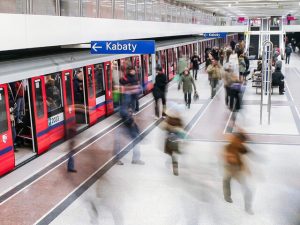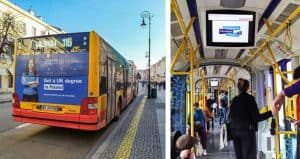🚋Transit advertising in major European capitals

Outdoor advertising has a huge impact on public space. It is a medium with a significant scale of reaching, so every customer can come across its message.This is mainly favoured by the location and the fact that it cannot be turned off.This makes it impossible to ignore it, on the contrary – it accompanies the audience everywhere and at every moment of their closer and further journey.Particularly noteworthy is advertising in public transport, and the following shows how it looks in the largest capitals of Europe.
If you list the advantages of advertising in public transport, it is not without reason that there are plenty of them. Among the most important benefits will surely be its wide reach, thanks to which the displayed message is able to reach not only a broad, but also demographically, socially and age-diverse population. Moreover, advertising in public transport is an extremely effective message due to its repeatability (high frequency of views), and this constant recall affects remembering. As there are most buses and trams on the (main) streets of cities, they are the largest form of advertising and offer the most diverse and creative advertising formats. According to the Road to Enlightenment survey conducted by QMedia1, 86% of consumers are able to recall a specific bus advertisement, and over 50% of recipients can describe in detail the advertisement seen in the last three days. It is certainly influenced by the proximity and the time people spend in public transport (on average, a passenger travels by public transport about 40 minutes a day). Moreover, public transport advertisements cover those residential and commercial areas of cities that are not reached by billboards. It is known that the consumer is not stationary, so advertising in public transport is not stationary. Public transport goes where people are, and it does so all over the world.
MARKET SIZE
Regardless of whether it is an advertisement in/on a bus, tram, bus stop or in the subway, thanks to advertising in public transport, you can reach millions of recipients every day and carefully control the messages posted. Advertisers of the largest European cities are aware of this, especially since the transport fleet in each of them is really impressive.
LONDON
London is the largest and most important city in Great Britain and the most visited city in the world (measured by the number of international journeys).With over 8 million inhabitants and about 4 million tourists a day, the metropolis is not only a financial, economic, political, cultural and tourist centre, but above all a paradise for advertisers who want to create a brand that is recognizable around the world.Advertising in London communication means success: 5 international airports, Eurostar high-speed rail, black taxis or one of the longest (11 lines) and oldest (because opened in 1863) underground, which serves over 5 million passengers a day and 1.357 billion annually. Do not miss the buses – and those famous red double-deckers that are London’s most recognizable symbols, and the single-deck articulated buses with the busiest route, Route 25, which carries around 19 million passengers per year. However, for promotional purposes, even a red “double-deck’ can change its colour to a more fruity one.
Advertising on the London transport network is an effective marketing tool: millions of views and a guarantee of a successful campaign. According to Statista2, in the fiscal year ended March 31, 2018, Transport for London (TfL) generated advertising revenue of over £152 million (£10 million more compared to 2017). That is why advertisers are very eager to promote themselves in urban transport, although they also have to deal with certain restrictions, especially in terms of the content presented. As a curiosity, it is worth mentioning the ban that entered into force in February 2019: the ban on advertising fast food across the public transport network in London (although some ads for these products are still visible due to the long reservation of advertising space by some companies). The mayor of London justified this by wanting to fight the “ticking time bomb” of childhood obesity in the capital, although the Advertising Association replied that the ban would have “little effect on the wider social problems that cause obesity.” Time will show…
PARIS
Public transport in Paris
Paris, as the political, economic and cultural centre of the country, is one of the most visited places in the world (after London and Bangkok). Over 2.2 million inhabitants and 17 million foreign tourists annually3 (especially because of the Eiffel Tower and Notre Dame Cathedral, which is under renovation after a recent fire) make the French capital a titbit for OOH advertisers. Of course, the streets of Paris and public transport offer many creative ways to connect with your audience. The capital’s public transport on the Seine includes underground trains, i.e. the tube, as well as trams that go to the outskirts of the city and an extensive bus network (with over 9,000 buses making up over 1,400 bus lines). If you add that every day more than 3.5 million Parisians and tourists use this rich transport fleet, public transport vehicles can be called “rolling” billboards. Widespread and clearly visible advertising on public transport has a lasting impact on pedestrians, drivers and passengers, including during waiting times. Among the many interesting projects, it is worth mentioning the campaign from a few years ago under the slogan: “Restons civils sur toute la ligne” (Let’s stay polite all the way, own translation), aimed at restoring courtesy in the Paris underground. A study published by the municipal transport authority RATP (in which 97% of the surveyed passengers said that they had witnessed basic social violations at least once in the last month) was the starting point for an advertising campaign comparing people who break the rules to animals. Among the worst manners there were, for example, loud conversations on the phone, which was presented by a billboard with the inscription: “At 86 decibels, no secret is a secret anymore.” The action met with a great response, which resulted in the website www.chervoisin2transport.fr (“dear neighbor from the means of transport”) established by RATP, where people could make memes about “crimes against courtesy” in public transport.

BERLIN
Public transport in Berlin
Berlin, next to London and Paris, is the most visited city in Europe. With 3.6 million inhabitants (from over 190 countries) and 13.5 million tourists each year, it is possible to reach any target demographic group. This huge metropolis with two airports, trams, underground trains (U-Bahn) and city trains (S-Bahn) and a bus fleet of over 1,500 buses (which run on almost 200 lines) is an undeniably proven way to an effective campaign or branding. In Berlin, a journey by public transport usually takes about 15 minutes (reaching the destination or a change), which, according to German advertising agencies, is enough time to familiarize passengers with interesting advertising messages. The main arguments for advertising in public transport are the fact that many Berliners and tourists use public transport, because the transport system is inexpensive, not very complicated and the fastest in Europe. What’s more, advertising in public transport saves time and costs thanks to the use of self-adhesive vinyl technologies, which can be quickly applied to the sides, rear and even the entire vehicle (and quickly removed), as in the case of alcohol advertising on a bus in Berlin.
advertising on a bus in Berlin
Due to its international character, tolerance and openness, Berlin attracts advertisers from all over the world. For example, in the first half of 2016, Coca-Cola was among the most advertising companies in Berlin, with advertising expenditure of approximately EUR 76.5 million4.
WARSAW
Advertising in public transport in Warsaw
Warsaw’s public transport is primarily trams, buses, SKM ( rapid urban rail), airport and underground. The dominant role in public transport is played by buses (with a fleet of 1,500 vehicles), which operate over 240 urban, suburban and night routes and carry over 42 million passengers each month. Public transport also includes more than 420 trams, 48 metro trains at the communication rush (which are used by about 600,000 passengers a day) and SKM (every day it transports over 65,000 commuters from suburbs and towns near Warsaw). In total, over a billion Varsovians and tourists travel by public transport in Warsaw annually5. Advertising in public transport is a guarantee of reaching the customer on a large scale and at a low cost, which is why it is popular among advertisers. According to the IGRZ (Outdoor Advertising Chamber of Commerce) report summarizing 2018, transit advertising grew by 29% compared to 20176. Where does such success come from? First of all, it is the result of an innovative and technologically modern approach to presenting an advertising message, a very large number of recipients and a wide range.
The direct availability of the target demographic group, flexibility in broadcasting the advertising message and the possibility of using non-standard formats (including multimedia spots) mean that advertising in public transport enjoys unflagging interest among consumers. In addition, due to the possibility of selecting carriers, it is also an ideal solution for campaigns with a lower budget.
advertisements on buses and trams
Transit advertising in public transport
Advertising on buses and rail vehicles (trams, trains, underground) is extremely effective. They create countless impressions among pedestrians, drivers, cyclists and commuters. When you add a wide range of street furniture, such as bus stops, train stations, information panels that use passengers’ waiting time, it turns out that transit advertising is a really effective promotion tool and long-term brand image building. When talking about advertising in public transport, it is worth noting that it can be placed on almost anything: inside the vehicle (LCD screens), outside (partial and full wrapping), at stops, in waiting rooms and at stations and terminals (billboards, digital screens, flags, posters, showcases, banners, floor graphics).
When customers see such advertisements, consciously or subconsciously, they will be subject to a specific brand or its message. The size of the market, unlimited possibilities as to the form, length of emission and location mean that advertising in public transport leads to the desired effect, which is to create a lasting impression and increase sales.
See our offer in urban transport https://be-media.com.pl/en/advertising-in-public-transport.html
References:
- https://slideplayer.com/slide/1509264/
- https://www.statista.com/statistics/898278/transport-for-london-advertising-revenue/
- Top 20 miast najchętniej odwiedzanych przez turystów w 2018 roku, Business Insider, 13 października 2018 [dostęp 2019-11-02] (pol.).
- https://www.statista.com/statistics/611466/advertising-expenditure-berlin-companies/
- https://www.ztm.waw.pl/statystyki/
- http://igrz.home.pl/RAPORT%20OOH%202018.pdf











